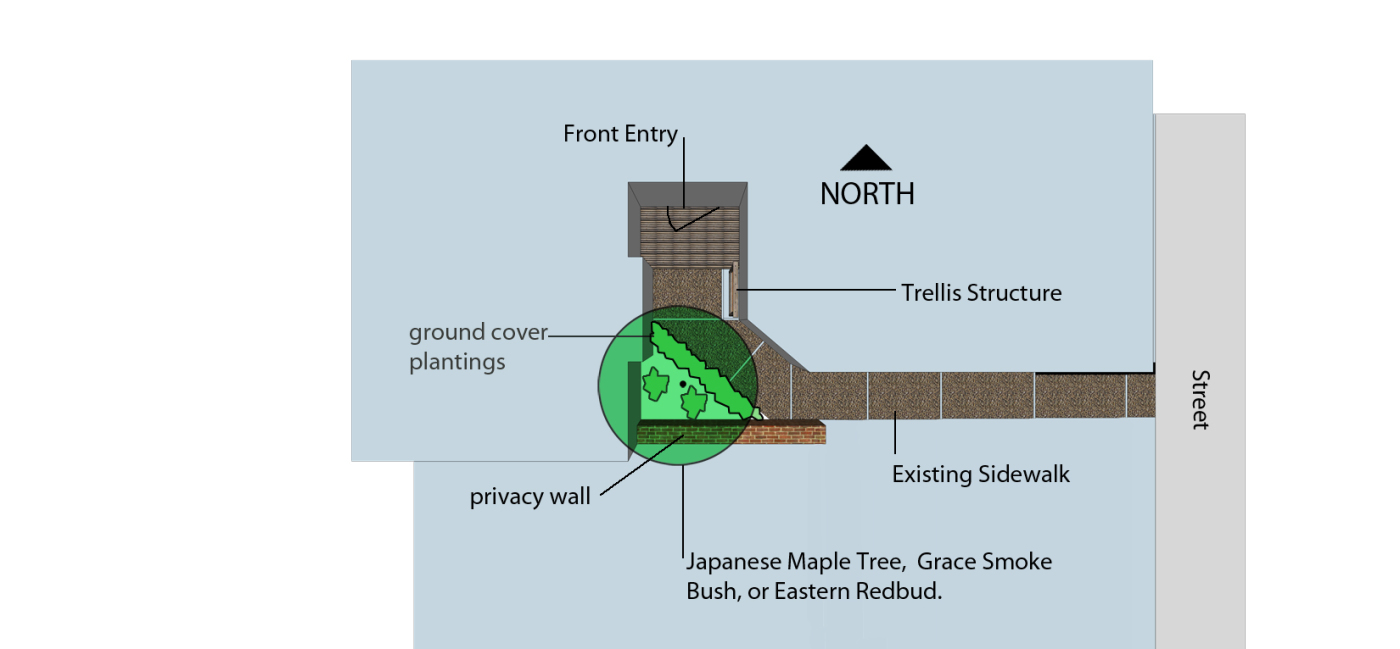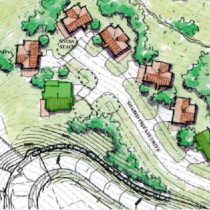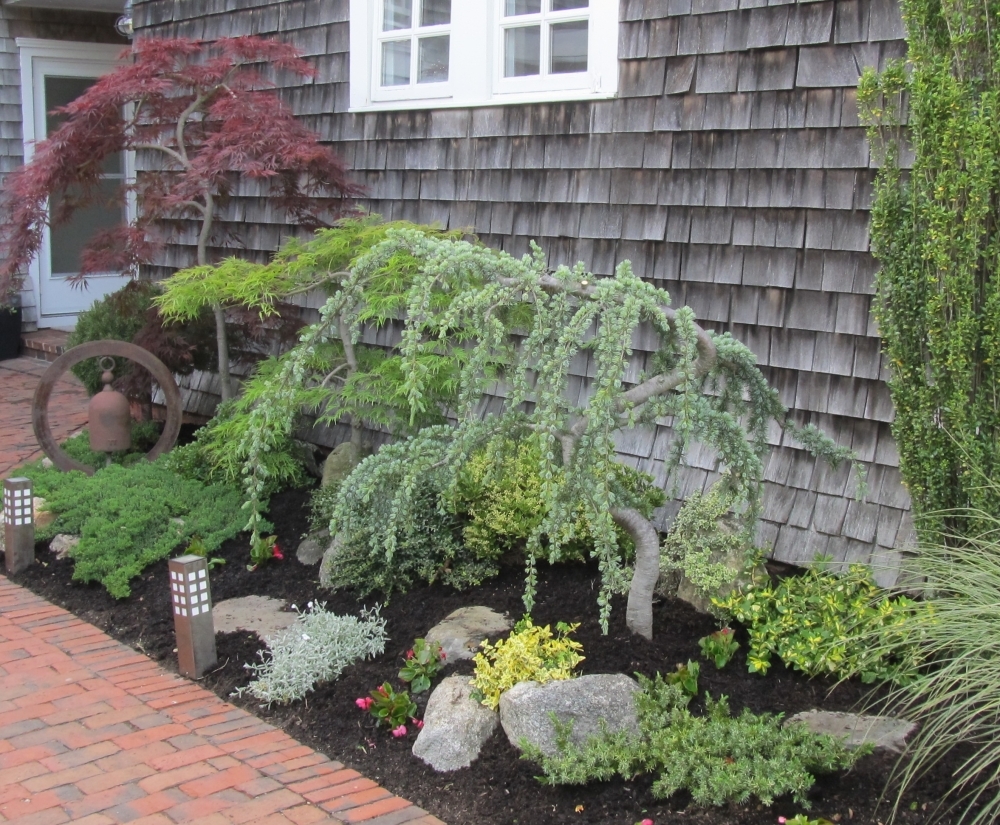Landscape Architecture for Landscape Architects › Forums › GENERAL DISCUSSION › How close is too close? Planting ornamental trees near a foundation.
- This topic has 1 reply, 15 voices, and was last updated 13 years, 1 month ago by
 Phil O’Donnell Jr..
Phil O’Donnell Jr..
-
AuthorPosts
-
October 19, 2012 at 6:16 pm #156195
Jay Ryan Courtney
ParticipantI am designing a small entry landscape for a client and would like to plant a an ornamental tree close to a foundation and side walk. I would like to select a tree for it’s seasonal interest and branching character. I know I could plant a larger shrub but I am looking for the branching structure and openness of a small tree. From peoples experience what is the closest you would want to comfortable plant without worrying to much about heaving side walks and potential foundation problems? I know I often see smaller trees close to foundations, but how good of an idea is this?
For scale the side walk is 3.5′ wide and the privacy wall is 4′ tall. The house surrounds entry garden to the North, East, and west.
 Any experiences or advice on this?
Any experiences or advice on this?Thanks!
October 19, 2012 at 9:54 pm #156213 Phil O’Donnell Jr.Participant
Phil O’Donnell Jr.ParticipantI think the trees listed on the plan would not raise concern in terms of sidewalk heaving or foundation problems. Shade trees that become much larger at maturity would be of concern for the sidewalk and possibly the foundation. The concern I would have would be which plant isn’t going to become mis-shaped or pruned into some unnatural form as it is pruned away from the house and privacy wall over the years. For this reason I would go with a multi stem Redbud.
October 20, 2012 at 1:50 am #156212 earthworkerParticipant
earthworkerParticipantAll of those plant selections will grow too large for the space. They will grow into the walk and impede movement. As you have it drawn, the trunk is only a foot away from the walk. That’s not even enough room for the root ball nor an adequate tree pit with amended soil. The maple needs water and shade which might not be available. The Redbud’s branching will over take the space and they need specific soil amendments to do well. The smoke bush will get way too big.
I would maintain a minimum of 8′ at the absolute least for the smallest orn tree away from foundation. I would keep all plantings away from foundations by at least 4-5′ due to irrigation and water infiltration. I would suggest a Tall Hedge Buckthorn or Armstrong Maple but I really think the space is too small for tree.
October 20, 2012 at 11:53 am #156211 Andrew Garulay, RLAParticipant
Andrew Garulay, RLAParticipantThere is more to consider than the size of the space and ultimate site of the plant.
Life span of this garden is one of them. It is not uncommon for some people to re-landscape or alter a landscape in a short number of years. Others may do little or nothing for many years.
Maintenance is the next big issue. Not only whether there will be a maintenance program, but what the knowledge and skill level is of those whom are doing it. If you set it and forget, a Japanese Maple will over take that space ( looks like roughly 5’x6’x~8′?) rather quickly. If it is pruned annually for shape and size it could last and function for many years. If it is routinely root pruned it can function for many more years without impacting the hardscape.
Landscape maintenance is not what it used to be. There are plenty of people out there doing it and very few of them pay attention to this type of detail and fewer know what to do about it when they do. It no longer makes sense to accept that proper maintenance will be done. Unless you know otherwise, expect minimal maintenance and minimal knowledge and skill applied in that maintenance.
I would not consider a Redbud, but if the client understands the required maintenance or short duration I would consider certain Japanese Maple cultivars.
The picture in my avatar is a 6′ x 16′ bed with two Japanese Maples and a Weeping Blue Atlas Cedar in it as well as a number of other shrubs. That planting is six years old, but I maintain it. Joe’s lawn care would have a different result.
Like any other variables considered in the design process, time span and maintenance are just as important as sun light and soil conditions. The big difference is that you can accurately asses soil and light conditions, but you have to rely on information given to you and the commitment of your client to properly apply the right values when considering life of the landscape and degree of maintenance. When in doubt, low maintenance and long duration should be the default.
October 21, 2012 at 10:38 am #156210Ernst Glaeser
ParticipantI would advise to use something fork-stemmed, but no a maple. Have something deep or heart shaped rooting. Go and see the nurseries for a tree being a reject for it’s standard. Have the 2 or 3 stemms cleared to a hight of 2m. Choice of tree is difficult to say from here. One thing is right, you need the space from the edge of your walway to allow callipper to grow. I believe that trees and grading are not as often changed as other fashionable garden elements. Trees mature with age.
October 21, 2012 at 6:01 pm #156209Anonymous
Inactive
Lollipop Crabapple?
The fruit shouldn’t be much of a problem.
October 22, 2012 at 4:29 pm #156208Jay Ryan Courtney
ParticipantThanks for the input everyone.
I’m not to concerned about the “hack job” pruning of a tree for this space. I being a Certified Arborist am going to make clear to the client to only have a high end tree care company with Certified Arborist prune this tree over the years and to have it pruned to keep it’s natural shape and form. I have pruned many trees in small spaces and know from experience that it is possible too keep a natural looking form in a tight spot if care and patience is practiced.
Again my concern here is the foundation and side walk. I have seen mature red buds with close to 1′ caliper so my concern is “would this harm the foundation”?
As people have mentioned, some landscapes are shorter lived. I’m thinking maybe these trees listed or something similar would be ok for 20 yrs. or so with no worries on the foundation? If so I think the client and I would be happy with a choice like this.
October 22, 2012 at 5:29 pm #156207 Jonathan P. Williams, RLAParticipant
Jonathan P. Williams, RLAParticipantLooking at the plan I would think the area is really tight to bring a tree into the mix.
Only idea is maybe check into some miniature cultivars of Ginko biloba
Design it with a tree and do something really cool without one..like maybe tall perennials that hold their structure through the winter?
October 22, 2012 at 6:26 pm #156206 Jordan LockmanParticipant
Jordan LockmanParticipantI agree you are really limited to a small patio style tree with the space you are showing.
October 23, 2012 at 3:00 am #156205 ncaParticipant
ncaParticipantI wouldnt worry about the tree causing heaving so much as the canopy being far too low and wide for the space. Also consider signage and visibility to the front entry.
October 23, 2012 at 1:53 pm #156204 Phil MooreheadParticipant
Phil MooreheadParticipantPerhaps you can propose putting a Japanese Maple in a large decorative pot? That will give you a couple extra feet of overhead clearance, keep the tree artificially small, and you’ll know exactly where the roots are. I would also suggest something with an upright habit, like the ‘Sango-Kaku’.
A tree in this space is essentially containerized anyway, you might as well capitalize on it.
October 23, 2012 at 2:43 pm #156203 Trace OneParticipant
Trace OneParticipantJust to play devils advocate, I personally love the sight of a huge tree in a small urban space, I think it gives the space a true- er scale – I second the vote for a Gingko, they have great bark when they get old, and if you have a teeny space don’t clutter it up with a lot of teeny plants..
October 24, 2012 at 10:30 am #156202 tobyParticipant
tobyParticipant“…going to make clear to the client to only have a high end tree care company with Certified Arborist prune this tree over the years and to have it pruned to keep it’s natural shape and form…”
That will work as long as EVERYBODY knows this. What happens when an uninformed maintenance worker hacks at it, or the current homeowner moves out ?
October 24, 2012 at 11:33 am #156201 Andrew Garulay, RLAParticipant
Andrew Garulay, RLAParticipantNo one is going to bring up the irony that it is assumed that the situation is fine if a Certified Arborist is caring for the tree while it is a Certified Arborist asking if it will work? No disrespect for Jay or any other CA, but this question does not seem to be a standard situation that all of them have with a standard game plan in place to deal with it or Jay would know the answer.
Maintenance commitment has to be part of your extended Site Analysis. You either have to make assumptions based on what you see if you have familiarity with the client, what they tell you, or what you gather through discussion with them. Those assumptions have to be guide you for limitations and opportunities just as climate, sun light, and soil do. No one on this web site can get that information better than Jay can because he is the only one dealing with his client.
I think that there must be doubt that the client will apply the right resources to sustain a tree in that space or the question would not be asked. Then the question is really about what can we get away with in this space that will not require any special maintenance and/or for how long can which tree do what we need it to do in this space without being a problem.I have no problem with that question being asked. It is quite reasonable.
If that is the case, the biggest worry is how soon the roots may start to pose a problem to the hardscape since they will be the unseen and most ignored potential problem. The next big problem is how soon the branching will out grow the space that you have. Assume that it may not get special care and make your tree selection based on well behaved roots, plant form, and rate of growth (above ground). It won’t last forever, but nothing does in a manufactured landscape.
October 24, 2012 at 6:18 pm #156200mark foster
ParticipantYou may want to consider Serviceberry (Amelanchier).
-
AuthorPosts
- You must be logged in to reply to this topic.



